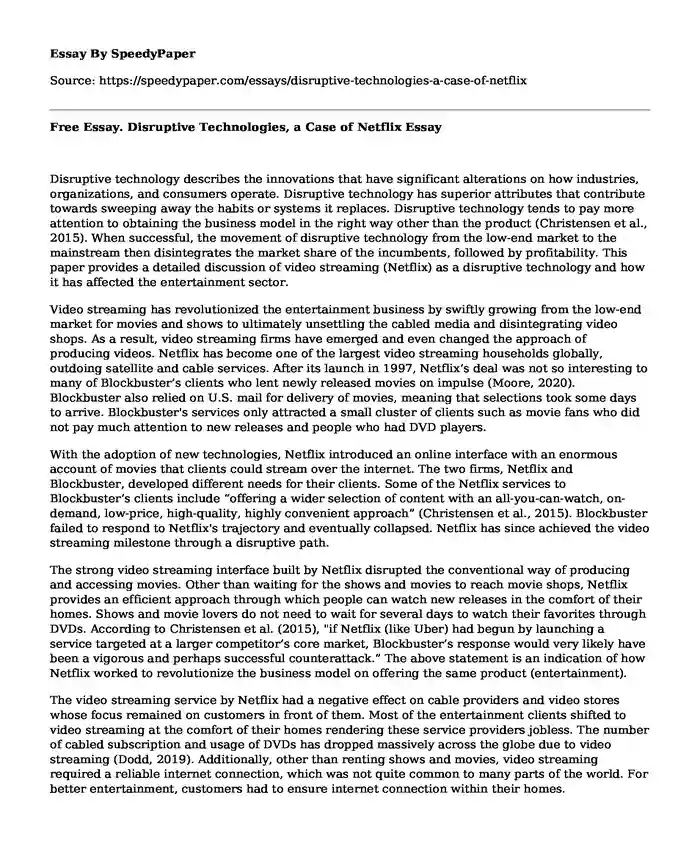
| Essay type: | Compare and contrast |
| Categories: | Company Analysis Electronics |
| Pages: | 3 |
| Wordcount: | 667 words |
Disruptive technology describes the innovations that have significant alterations on how industries, organizations, and consumers operate. Disruptive technology has superior attributes that contribute towards sweeping away the habits or systems it replaces. Disruptive technology tends to pay more attention to obtaining the business model in the right way other than the product (Christensen et al., 2015). When successful, the movement of disruptive technology from the low-end market to the mainstream then disintegrates the market share of the incumbents, followed by profitability. This paper provides a detailed discussion of video streaming (Netflix) as a disruptive technology and how it has affected the entertainment sector.
Video streaming has revolutionized the entertainment business by swiftly growing from the low-end market for movies and shows to ultimately unsettling the cabled media and disintegrating video shops. As a result, video streaming firms have emerged and even changed the approach of producing videos. Netflix has become one of the largest video streaming households globally, outdoing satellite and cable services. After its launch in 1997, Netflix’s deal was not so interesting to many of Blockbuster’s clients who lent newly released movies on impulse (Moore, 2020). Blockbuster also relied on U.S. mail for delivery of movies, meaning that selections took some days to arrive. Blockbuster's services only attracted a small cluster of clients such as movie fans who did not pay much attention to new releases and people who had DVD players.
With the adoption of new technologies, Netflix introduced an online interface with an enormous account of movies that clients could stream over the internet. The two firms, Netflix and Blockbuster, developed different needs for their clients. Some of the Netflix services to Blockbuster’s clients include “offering a wider selection of content with an all-you-can-watch, on-demand, low-price, high-quality, highly convenient approach” (Christensen et al., 2015). Blockbuster failed to respond to Netflix's trajectory and eventually collapsed. Netflix has since achieved the video streaming milestone through a disruptive path.
The strong video streaming interface built by Netflix disrupted the conventional way of producing and accessing movies. Other than waiting for the shows and movies to reach movie shops, Netflix provides an efficient approach through which people can watch new releases in the comfort of their homes. Shows and movie lovers do not need to wait for several days to watch their favorites through DVDs. According to Christensen et al. (2015), "if Netflix (like Uber) had begun by launching a service targeted at a larger competitor’s core market, Blockbuster’s response would very likely have been a vigorous and perhaps successful counterattack.” The above statement is an indication of how Netflix worked to revolutionize the business model on offering the same product (entertainment).
The video streaming service by Netflix had a negative effect on cable providers and video stores whose focus remained on customers in front of them. Most of the entertainment clients shifted to video streaming at the comfort of their homes rendering these service providers jobless. The number of cabled subscription and usage of DVDs has dropped massively across the globe due to video streaming (Dodd, 2019). Additionally, other than renting shows and movies, video streaming required a reliable internet connection, which was not quite common to many parts of the world. For better entertainment, customers had to ensure internet connection within their homes.
Conclusion
Though having disrupted the conventional way of producing and offering entertainment, video streaming has improved the sector by providing a wide range and quick access to shows and movies in a centralized platform. Additionally, video streaming technology offers an extensive range of media accessibility, including in mobile devices, thus allowing entertainment lovers to enjoy whatever they want at any location ad on the device they like.
References
Christensen, C. M., Raynor, m. E. & McDonald, R. (2015, December 1). What is disruptive innovation? Harvard Business Review. https://hbr.org/2015/12/what-is-disruptive-innovation
Dodd, A. Z. (2019, April 18). Streaming—A disruptive technology | What is the internet | InformIT. InformIT: The Trusted Technology Source for IT Pros and Developers. https://www.informit.com/articles/article.aspx?p=2963467&seqNum=3
Moore, R. (2020, May 27). Eleven disruptive innovation examples (And why Uber and Tesla don't make the cut). OpenView. https://openviewpartners.com/blog/11-disruptive-innovation-examples-and-why-uber-and-tesla-dont-make-the-cut/#.XtDUwlUza00
Cite this page
Free Essay. Disruptive Technologies, a Case of Netflix. (2023, Aug 16). Retrieved from https://speedypaper.com/essays/disruptive-technologies-a-case-of-netflix
Request Removal
If you are the original author of this essay and no longer wish to have it published on the SpeedyPaper website, please click below to request its removal:
- Worksheet On Radiation Essay Example
- Free Essay Example on Internet of Things
- Digital Citizenship Essay Sample
- Essay Example on Financial Performance Measurement
- Free Paper Sample: Prescription Drug Monitoring Programs
- Free Essay Sample - Failure Analysis
- Free Paper Sample on Internet and Electronic Database Research
Popular categories




